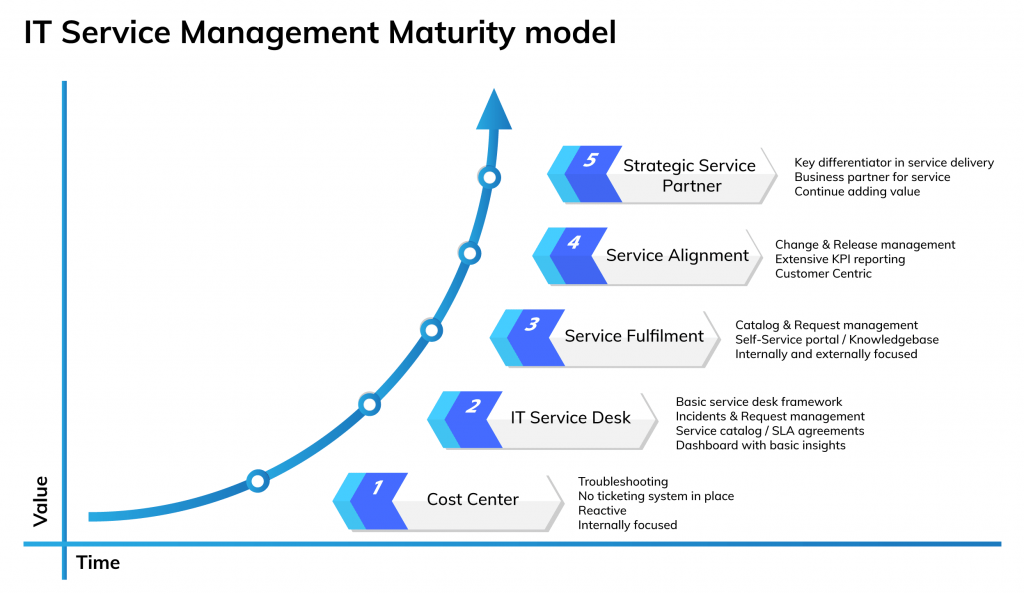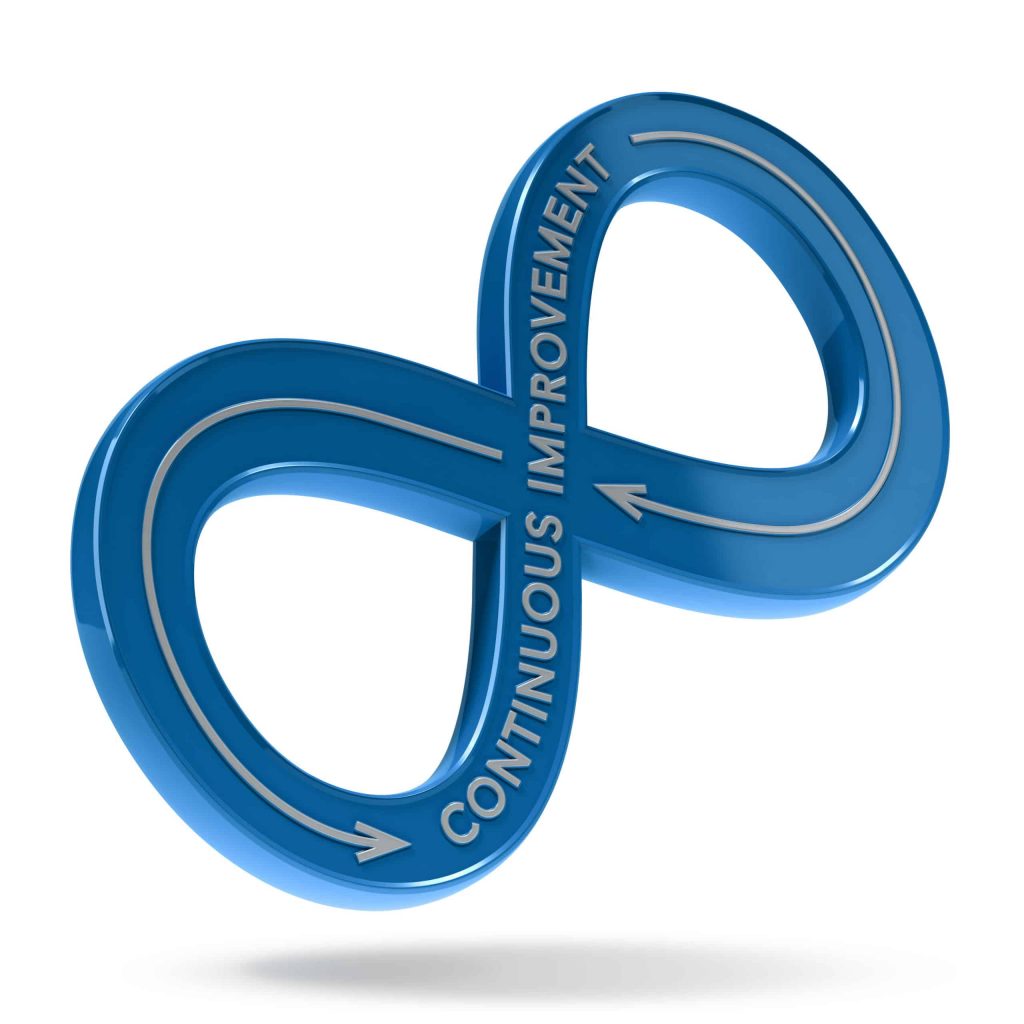In previous articles exploring the IT Service Management Maturity curve, I have set out stages 1-4 where an IT Service provider has put in place best practices that are aligned across the business with the customer at its center.
In this next and final blog, we reach the most mature stage, but first a word about the model itself. Although in the image below, the model is presented as an upward linear curve, ITSM is not a checkbox one-way approach, but rather one of constant re-appraisal and adjustment; as market demands change and new best practices emerge.

A good strategy allows the IT service to ensure it is still hitting the mark in all previous stages as it moves upwards. So, with the assumption that all previous stages are still being met and optimized we are ready to discuss the final step of ITSM Maturity.
Stage 5 – Strategic Service Partner is where IT service delivery becomes intrinsically linked with business strategies with added value demonstrated in real terms. The IT provider can now authentically consider themselves as a business partner to their customer; becoming more of a consulting advisor and directly impacting the strategy of their client through the service decisions they make together.
Strategic IT Service Management can be defined as adopting the ITSM approach for designing, providing, managing and refining the way IT is used within an organization to ensure that IT services are aligned with ultimate business goals.
It makes sure that the right processes, the right people and the right technologies are in place for an enterprise to meet its business goals, not just in the short term but in the long term. Given the strategic nature of a mature service provider, a common characteristic is one of continuous improvement in operations but also to have a challenging eye on the market, technologies and emerging innovations in order to steer and drive the business.
At the highest level of maturity, quality delivery by service departments is a key differentiator. Customer service is continually improved by delivering experiences and insights into where, when, and how the customer wants them. At level 5, the organization’s employees are empowered to take action to innovate and transform service departments into business partners, providing value by continually gaining a competitive edge for the entire organization.
Continuous service improvement for operations

Continuous service improvement (CSI) is based on the feedback loop and insights; it is necessary to differentiate and not only act as a leader but be a leader and strategic partner.
The CSI methodology is a seven step approach within ITIL and is based on the business management theories of W. Edwards Deming. Executed repeatedly, The Deming Circle involves a four-step loop of plan, do, check and act. This concept was adopted into the continual improvement goals of international standard ISO 20000 for IT service management.
- Identify the strategy for improvement
- Define what you will measure
- Gather the data
- Process the data
- Analyze the information and data
- Present and use the information
- Implement improvement
Aligned across all departments, continuous service improvement can be applied to all aspects of the ITIL approach to bring added value across the whole lifecycle. , Strategic ITSM can be defined as adopting the ITSM approach for designing, providing, managing and refining the way IT is used within an organization to ensure that IT services are aligned with ultimate business goals. It makes sure that the right processes, the right people and the right technologies are in place for an enterprise to meet its business goals.
Business transformation for strategic service delivery
A methodology that can work is to use the Digital Maturity Assessment for business transformation. We often use it in order to understand where your organization is now (in terms of people, processes and technology) and where it wants to go to. This way of scoring yourself as an IT service partner allows you to benchmark yourself against the market and then take steps to move forward.
It is important to understand that customers and colleagues lie at the heart of sustained business success.
A digital maturity assessment works across four key areas: Innovation, Operations, Employees and Customer Experience. You can take one or more of these assessments, in order to build up a holistic picture of your readiness to move forward and transform.

You can take the assessment now, simply choose your sector as Professional Services, receive a score and a report on next steps…

Innovation for service providers
IT and service-oriented organizations can face challenges if they do not innovate. Inspire and discuss new technology like virtual agents, self-service portals, Machine learning and AI.
Clients are price sensitive, have complex service needs, press on delivery times, SLAs, and demand high quality.
The clients of these organizations themselves face challenges in digital transformation and expect guidance and innovation from their partners. Service oriented firms must be able to organize and modify the physical and organizational structures necessary to deliver services effectively and efficiently. They are shifting toward new delivery models by incorporating core client teams: a flexible model team, a shared service team, and specialist team structures.
With its focus on the human connection and the service experience, Services companies must be well prepared for digital transformation with their proximity to the customer demands of today and tomorrow.
Providing teams with embedded guided processes and workflows that align with specific industry best practice (take ITIL for example) that can often be the differentiator in disruptive markets.
Unifying your systems so that agents can access customer assets supports both CX and EX best practice and builds advocacy.
Employee Experience in service organizations
People buy from people, a fundament in the Services sector. The modern employee is our internal customer, therefore the need to think in terms of Employee Experience (EX) rather than HR is key. Professional Services companies who recognize this are reaping the rewards of employee retention and advocacy.
When delivering a service, the customer remembers WHO they engaged with as much as WHAT was provided; therefore, if we think of our workers as brand ambassadors, we are on the right track. EX best practice means looking at the entire lifecycle of an employee; from Hire to Retire. Recruitment and onboarding must be professional and agile, making a great first impression to the candidate and supporting them in their objectives.
Employers who keep teams collaborating, productive and skilled according to their business and personal objectives see results in efficiency and engagement.
Providing teams with the modern tools and processes they expect, that do not impede them in their tasks and their career is vital. Management who can easily track performance and training needs enjoy greater engagement from teams and alignment with business objectives.
Operational Excellence for ITSM
Centralizing and unifying processes and methodologies such as Customer Service Management, IT Service Management and integrating Business Intelligence is a solid foundation to standardize services, position your offering and optimize talent.
Providing teams with embedded guided processes and workflows that align with specific industry best practice (take ITIL for example) that can often be the differentiator in disruptive markets.
Customer Experience in professional services
With its focus on the human connection and the service experience, a Service company must be well prepared for digital transformation with their proximity to the customer demands of today and tomorrow.
Innovators are focusing on the entire Customer Experience and finessing their service provision as a result. CMOs who use analytic tools and digital Customer Journey Maps to provide personalized, seamless experiences across channels are succeeding in this personalization demand.
Personalization comes from a true understanding of your customer and how to interact with them. The need to structure and unify customer data across all sources is key in reaching this understanding.
Remaining a key differentiator in IT Service Management
In this article I have shown that in order to reach and remain at the top level of ITSM Maturity, providers must not only put in place mechanism for continuous improvements in their daily operations but also to place emphasis on their strategic direction, knowledge and value in order to be seen as a valuable partner to the business.
Article initially published on LinkedIn






